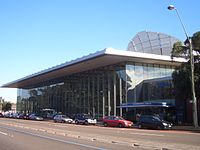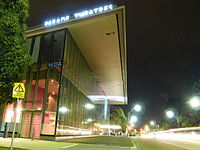- National Institute of Dramatic Art
-
National Institute of
Dramatic Art
Motto Excellence, Innovation and Access in Arts Education Established 1958 Location Kensington, New South Wales,  Australia
Australia
33°54′57″S 151°13′31″E / 33.9158°S 151.2252°ECoordinates: 33°54′57″S 151°13′31″E / 33.9158°S 151.2252°EWebsite www.nida.edu.au The National Institute of Dramatic Art (NIDA) is an Australian national training institute for students of theatre, film, and television, based in the Sydney suburb of Kensington. It is supported by the federal Office for the Arts, Department of the Prime Minister and Cabinet. NIDA is located adjacent to, and has a strong relationship with, the University of New South Wales. It is a member of the "Australian Roundtable for Arts Training Excellence".[1]
Contents
History
Established in 1958, the Southern Institute of Dramatic Art was opened in 1959 with only 23 students and two staff members. The second course offered was in acting. Over the years, courses in areas such as film production, design, theatre director, and production crafts were added.
Admission
Admission to NIDA is extremely selective, and its auditions highly competitive; on average, only one out of every one hundred applicants is accepted. Each year, approximately 24 actors, 6 directors, 6 playwrights, 14 production students, 8 designers, 5 properties students and 4 costume students are admitted.
Graduates from the institution's three-year tertiary education program have gone on to national and international success.
Campus
In April 2002 the new NIDA complex was opened. NIDA's facilities include:
- A 725-seat proscenium arch style theatre with stalls, two galleries, a large stage, fly tower and orchestra pit (Parade Theatre)
- A self-contained flexible studio theatre, seating 155, with a wrap-around mezzanine and steeply raked seating (Parade Playhouse, formally the NIDA Theatre)
- Two intimate 80-120 seat spaces with flexible seating arrangement (Parade Studio and Space)
- Reg Grundy Studio for film and television training and production
- A library to accommodate NIDA's theatre and media collection of books, DVDs, CDs, audio-visual and multi-media material
- Rehearsal rooms for training, outside hire, and NIDA's Corporate Performance and Open Program courses.
- A foyer space for formal occasions such as product launches, conferences, and sit-down dinners for 300 people.
- Scenery, Properties and Costume workshops for manufacturing and maintaining production elements of NIDA productions
- Lighting and Sound studios for the training of students
Courses
The National Institute of Dramatic Art provides education and training for the arts and entertainment industry including; full-time courses, short courses and corporate training. The theatre complex hosts in-house and commercial productions. NIDA houses Australia's largest performing arts library and a broad range of theatre resources and archives.
Full-time
Full-time courses at the National Institute of Dramatic Art include:
- Acting (Bachelor of Dramatic Art)
- Design (Bachelor of Dramatic Art)
- Production (Bachelor of Dramatic Art)
- Costume (Bachelor of Dramatic Art)
- Properties (Bachelor of Dramatic Art)
- Directing (Grad. Dip. Dramatic Art or Master of Dramatic Art)
- Playwriting (Grad. Dip. Dramatic Art)
Short courses
The National Institute of Dramatic Art also offers a range of short courses, each relating to the dramatic arts. Such subject areas include acting, design, production, directing and voice, all of which are offered to members of the general public.
The Corporate Performance department provides executives and business professionals with access to acting, voice and movement practitioners for training in improving business presentations and communications.
Staff
The National Institute of Dramatic Art has many prominent industry professionals visit the institute throughout the teaching year to assist in the training of students in their selected fields.[citation needed]
- CEO & Director: Lynne Williams
- Operations Director: Allan Morgan
- Student&Staff Services Director: Julia Selby
- Interim Head of Acting: Andrew Ross
- Head of Music: Andrew Ross
- Head of Properties: Todd Arthur
- Head of Movement: Lisa Minnett
- Head of Design: Michael Scott-Mitchell
- Head of Directing: Egil Kipste
- Head of Production: Mikkel Mynster
- Head of Stage Management: Stephanie Kamasz
- Head of Production Crafts: Nick Day
- Head of Costume: Fiona Reilly
- Head of Scenery: Tony Pierce
- Head of Open Program: Mark Gaal
- Head of Corporate Performance: Mark Gaal
- Head of Playwrighting: Jane Bodie
- Technical Manager: Marcus Kelson
- Facilities Manager: Peter Fisher
- Manager, IT: Udaya Krishna Puttagunta
- Producer, Parade Theatres: Johanna Mulholland
Program
Play productions are NIDA's most important teaching activity, with around 20 plays being produced at NIDA each year.
Each course is centred on training practitioners for work in the industry. Each day provides students with a structured series of activities, which balance the acquisition of skills with artistic excellence.
All the full-time courses are conducted in two modes. The first, the Teaching Program, consists of formal class work, practical instruction, seminars and research, often supplemented by periods of secondment in the industry. As part of the teaching program, students attend formal classes, seminars and/or discussion groups.
The second mode, the Production Program, provides practical learning experiences. Each student is given the opportunity to practice the intellectual, imaginative and technical skills acquired in the Teaching Program, working in the performance, design, manufacture or management of productions for presentation to the general public. Production work involves morning, afternoon, night and weekend rehearsals or performances.
The NIDA School Year consists of four terms of 6 to 12 weeks. Courses usually commence in early February and end in early November.
Productions
Play productions are the National Institute of Dramatic Art's most important teaching activity. Actors in particular learn by repetition, by performing a role many times in the theatre before different audiences. Once they have acquired the basic skills, students in the other courses learn by taking on the kinds of responsibilities they will be faced with in the industry.
All NIDA plays are a microcosm of the industry, with every element of the production from lighting and set construction to costumes and properties being produced by the students.
There are also opportunities to develop skills for working in film, with Acting students having access to a film and television studio.
Graduate careers
Graduates of the National Institute of Dramatic Art's full-time courses go on to work in a range of careers, in industries including film, theatre, television, opera, dance, animation, puppetry and events.
NIDA courses are professionally effective and there is a high rate of employment of graduates in the expanding Australian and international arts entertainment industry.[citation needed]
Alumni
See also: Category:People educated at the National Institute of Dramatic ArtNotable graduates from the National Institute of Dramatic Art include:
- Mel Gibson
- Trilby Glover
- John Hargreaves
- Joe Hasham
- Tom Long
- Baz Luhrmann
- Jessica Marais
- Catherine McClements
- Scott McGregor
- Jacqueline McKenzie
- Greg McLean
References
- ^ Department of the Environment, Water, Heritage and the Arts (2008-09-15). "Arts training bodies" (html). http://www.arts.gov.au/arts_training_bodies. Retrieved 2008-10-03.
External links
Categories:- Australian tertiary institutions
- Drama schools in Australia
- Education in Sydney
- Film schools in Australia
- Theatres in Sydney
Wikimedia Foundation. 2010.


